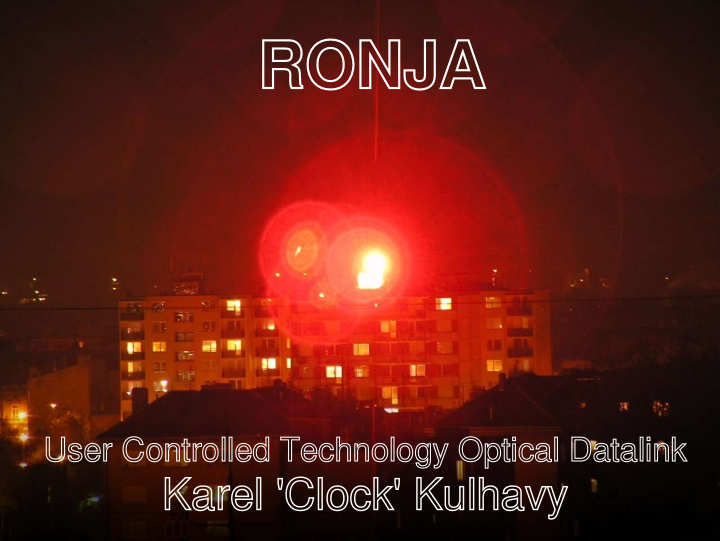



RONJA User Controlled Technology Optical Datalink Karel 'Clock' Kulhavy
● 1998: Experiments with IrDA 115.200 Baud ● 2005: – 10Mbps – 1.4km range – Full duplex – Red or infrared ● User Controlled Technology (UCT) ● A project of Twibright Labs
Range ● Transmission by ordinary (infra)red light ● Rain, snow OK ● 1.4km range @4km visibility ● Stable, given by white noise from Sun
Transmitter ● LED from car brake light (cost 1$) ● 13cm lens (3$) ● 17mW of red light ● Unconditionally eye safe ● 4m spot @ 1km
Material and time cost ● 100$ for one device total material cost ● Most expensive components: – Electronic 1.20$ (16MHz crystal oscillator) – Mechanic 4$ (smoke pipe 1 meter) – Optic 2-15$ (130mm loupe) ● 70 hours building time for average Joe ● Much less hours with careful planning ● Most time spend on searching for tools and parts
Advantages ● No interference ● No spectrum regulation ● No electrosmog ● Difficult eavesdropping ● Smooth throughput ● Full duplex ● No packetloss
Disadvantages ● Dropouts on fog (no problem for ordinary usage) ● Mount requirements ● PtP topology only ● Mechanics: 10-20kg
Support ● "I have populated more than 20 Twisters and I have to say all worked on the first try." (Petr Seliger, Ronja mailing list) ● Adhere to the guide -> works on the 1 st try ● Doesn't work -> bug -> report to Ronja ML ● Bugs have priority to features
Ronja + WiFi backup ● “Ronja is a really robust device. It runs [on our 800m link] even if you cover 95% of the lens with a paper. That will be useful when a fog comes.” http://bakulak.czfree.net/news.html ● Can't wait even in thick fog? ● Special SW requirements – Immediate dropout detection
Modularity ● 3 different models (AUI, RJ45, red, infrared) ● 6 electronic modules (2RX, 2TX, 2interf.) ● 7 mechanic modules (6 consoles + 1 holder) ● 2 optical modules (90mm and 130mm heads) ● 1 Ronja = RX+TX+interface+optical head+holder+console+cabling ● 1 link=2 Ronjas ● PC or switch (managed)
Mechanical mounting ● Holder with fine and rough alignment ● 5 types of console – Chimney – Parallel – Perpendicular – Mast – Corner
Boards ● Twister, TX ● Download *.zip, e-mail to fabhouse, get boards by post. ● Standardized format accepted by all fabhouses ● No thinking required to order
SMD miniaturization ● Already done on another Twibright Labs project – I2C2P ● The same toolchain as Ronja ● Easily solderable by layman with $20 soldering gun ● Cheaper, faster to build than TMD
Freedom ● DIY for laymen ● Step-by-step guide ● Minimum skills required ● Various operations can be ordered ● Complete source codes online under GPL ● Only free software tools used on development ● Anyone can do his own fork if he doesn't like it
Advanced free software tools ● 3D modelling BRL-CAD ● 2D modelling QCad ● Schematics, boards: gEDA ● 250MB of source tree ● 2 hours make time
Installations ● 102 registered installations ● 57 km total length ● 9 different countries
Installation peculiarities ● 1.7km longest (Poruba, CZ) ● 1.3/0.4km analogue retranslation (Běhařovice, CZ) ● 990m student dormitory, 1000 students (SK) ● Prague: 21 links in one community network (CZFree.NET)
21 installations in Prague CZFree.NET ● Continuous community network ● Attempt for independent last-mile infrastructure ● Covers whole Prague ● Mostly WiFi ● Ronja solves interference
Postindustrial nature ● Widespread availability of raw material resources ● Byproduct of globalized consumerism ● Ronja can exploit IKEA EMU 0507/0518 box ● Drilling templates speed up manufacture
“It's not anymore about the product. Now it's about the attitude.” (Stacy Peralta, Dogtown and Z-Boys, 2001) Lucasvo holding prototype of bugfixed parallel console
Social aspects of UCT ● Age or education show not to be important for users or developer (I got no EE school) ● Breaks barriers ● Lot of fun with friends in the garage ● Modern autistic computer-addict lifts his ass from the computer and becomes a human again ● Consumption and power replaced by creativity
Humanistic aspects of UCT ● No more automaton conformist consumerism ● Both user and developer: – in control of the product – treated as fellow human, not exploited – individuality is respected (mailing list) ● More effective learning of technical subject than in school
Project bottleneck ● 90% of delopment cost is time ● Est. 80% done by me, 20% by other developers ● Time dedication of main developer (=me) ● Currently ~1 hour/day ● 8 hours/day would be optimal ● New developers slow in beginning (low usability of free software tools, lack of experience)
Project future ● 3.0km range with Fogtown TX (right) ● 100Mbps ● 2$ cheap laser pointer measured BW of 1GHz ● Ideal for 1Gbps!
Welding the Fogtown prototype
The End
References ● http://ronja.twibright.com Ronja website ● K.Banke, C. Houghton: A Cheap and Simple Experimental Wide-Band Laser Link, http://www.earthsignals.com/add_CGC/hr/Wb_Las ● http://twibright.com Twibright Labs website
What about historic urban zones? ● Ronja can be concealed – Behind a window – Behind a chimney ● Ronja is smaller than a satellite dish
How to make multipoint with Ronja? ● More Ronjas have to be installed in one place ● No interference occurs
Definition of UCT ● UCT is Free Software concept generalized to technology ● 4 essential freedoms (taken from Stallman): – The freedom to use the device as you wish – The freedom to study the source documents and change it to implement what you wish – The freedom to manufacture and sell the device – The freedom to publish modified versions
Recommend
More recommend